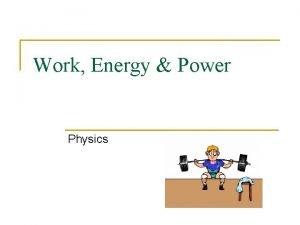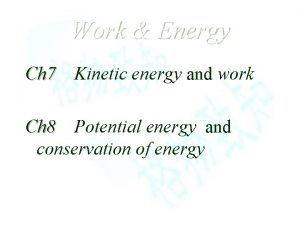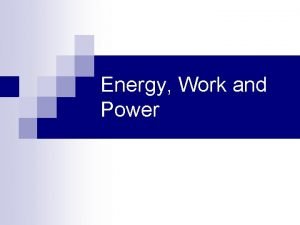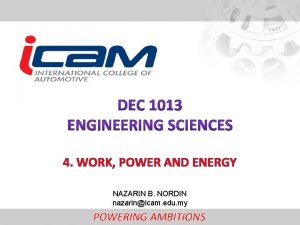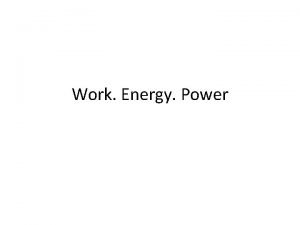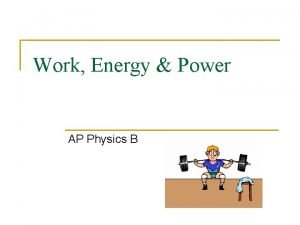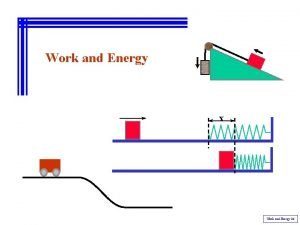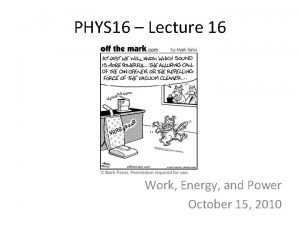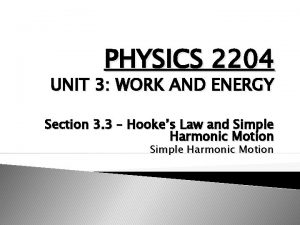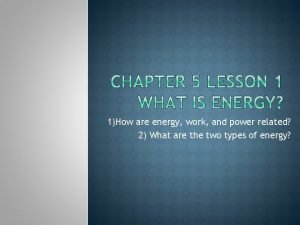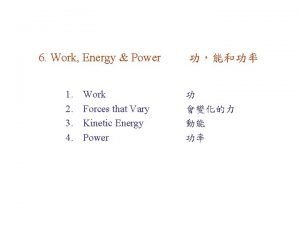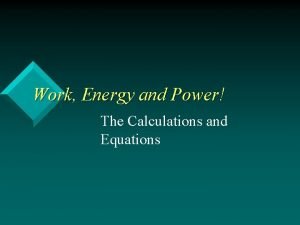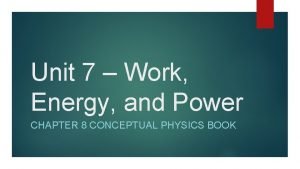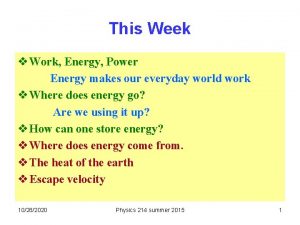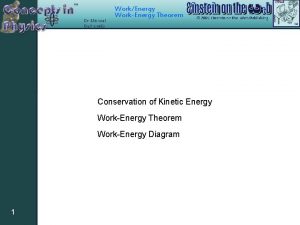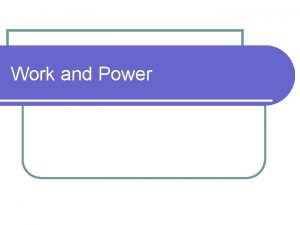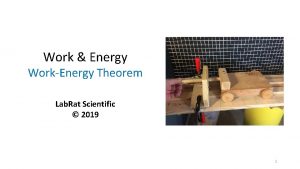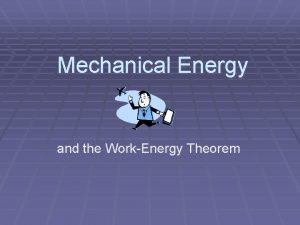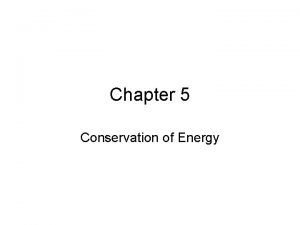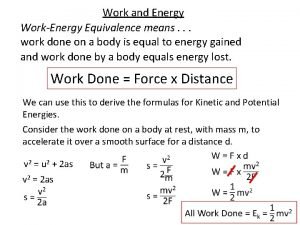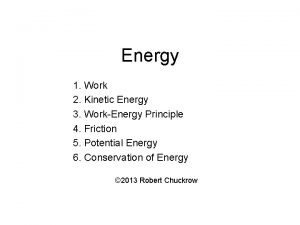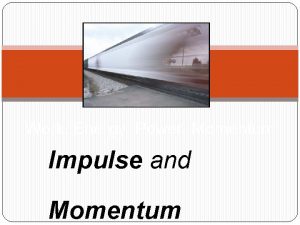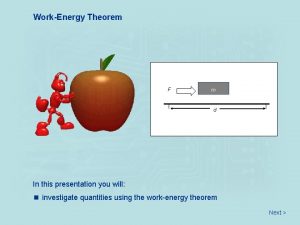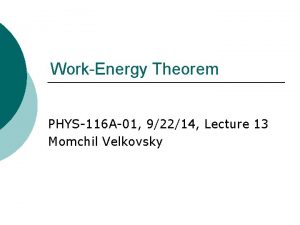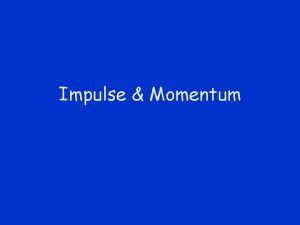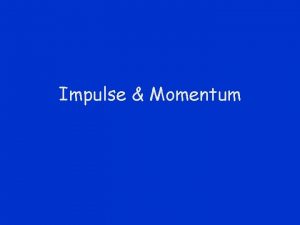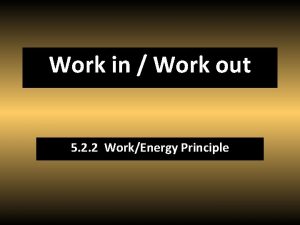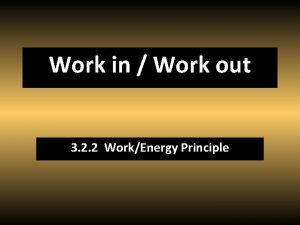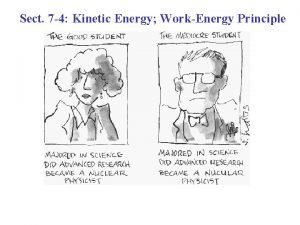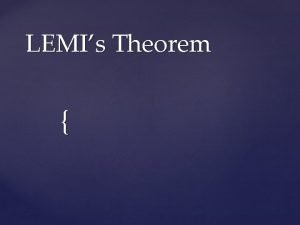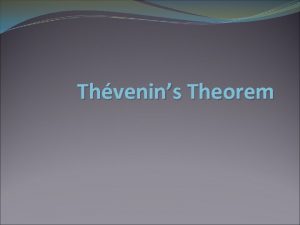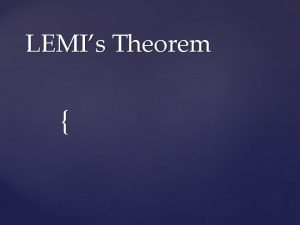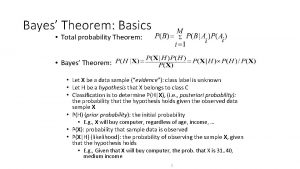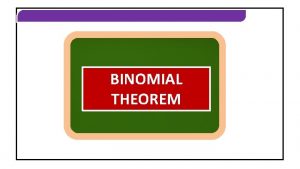Energy Work Power PE KE Workenergy theorem momentum




























- Slides: 28

� � � Energy Work Power PE KE Work-energy theorem momentum Impulse momentum theorem Conservation of momentum Momentum Gravity Newton’s law of gravitation Weight Value of g

Momentum Chapter 6

Key Concepts �Impulse �Momentum �The Impulse-Momentum Theorem �Conservation of Momentum

Impulse and Momentum � Impulse = Force x time Units are Newton-seconds: Ns � Momentum = mass x velocity Units are kg m/s � An Impulse on an object causes a change in the object’s momentum � Newton’s 2 nd law gives us a relationship between impulse and momentum

The Impulse-Momentum Theorem �The impulse on an object is equal to its change in momentum

Conservation of Momentum � The total momentum of a group of interacting objects remains the same in the absence of external forces � Examples: Cannon and cannonball Astronaut and wrench

Energy Chapter 7

Key Concepts �Work �Power �Kinetic Energy �Potential Energy �Conservation of Energy

Work � Work is done when a force is applied to an object and that object is displaced parallel to the direction of the force � Work = Force x distance (W=Fd) Units are Newton-meters (Nm) One Nm is also called a Joule (J)

� The object must move for work to be done Ex: you push a wall and the wall doesn’t move – no work is done � The displacement and the force must be parallel for work to be done Ex: A book slides across the table, but gravity does no work

Power �Power is the rate at which work is done �Power = Work / time (P = W / t) Units: J/s or Watts (W)

Kinetic Energy �Any is energy of motion moving object has kinetic energy �Mathematically: KE = (1/2)mv 2

How Speed Affects KE �KE is proportional to speed squared (v 2) �Therefore, double the speed and the KE increases by 22 = 4 �Triple 3 2= 9 the speed and the KE increases by

Gravitational Potential Energy (GPE) �GPE is energy associated with an objects height above the ground �Mathematically: m = mass g = 9. 8 m/s 2 h = height �The has GPE = mgh higher the object is, the more GPE it

Conservation of Energy � As the book falls, it loses GPE and gains KE � In other words, GPE is being converted to KE � However, constant the total energy (GPE + KE) remains

Work and Kinetic Energy �Ex: You push an object on a frictionless surface �You did work on the object and in the process changed its KE �It turns out the work done on an object exactly equals its change in KE �This is called the Work-Energy theorem �Mathematically: Work = ∆KE

Work and Potential Energy �Ex: You lift a book from the floor and put it on a bookcase �You did work on the object and in the process changed its GPE �The work done exactly equals the change in GPE �Mathematically: Work = ∆GPE

Chapter 9: Newton’s Law of Gravitation � Every object in the universe is attracted to every other object � The force of gravity between two objects depends on their mass and the distance between them � Mathematically: F = (Gm 1 m 2)/d 2

How Distance Affects Gravity �The force of gravity is inversely proportional to distance squared �Therefore, double the distance between two objects and the force becomes 22 = 4 times less �Triple the distance between 2 objects and the force becomes 32 = 9 times less

Ch. 36: Einstein’s Theory of Gravity �Relativity showed that space are time not separate and unrelated entities �They are united into one single entity called space-time �All events in the universe take place within the space-time continuum �Einstein visualized space-time as a fabric and showed that massive objects can warp this fabric

Curvature in Space-Time


Objects will follow the curvature in space-time

Light also follows curvature in spacetime

Black Holes �Massive stars will collapse violently at the end of their lives �The remnants of this collapse can be so dense that even light cannot escape its gravity �These “black holes” create severe curvature in space-time

Space-Time Around a Black Hole

The Event Horizon �Each black hole is surrounded by a boundary called its Event Horizon �Anything that crosses the event horizon is lost forever �In other words, we cannot obtain information from anything within the event horizon �Physicists are still struggling to unlock the secrets of black holes

Worm Holes � Worm holes are portals through the curvature in space that connect two distant points in the universe
 Physics 03-02 potential energy and conservative forces
Physics 03-02 potential energy and conservative forces Green's theorem vs stokes theorem
Green's theorem vs stokes theorem Conceptual physics momentum
Conceptual physics momentum Conservation of mechanical energy theorem
Conservation of mechanical energy theorem How many types of energy are there
How many types of energy are there Work energy theorem
Work energy theorem Conservation definition
Conservation definition Work-energy equation
Work-energy equation Energy vs work
Energy vs work Work energy theorem
Work energy theorem What is work energy theorem
What is work energy theorem Formula of kinetic energy
Formula of kinetic energy Work energy theorem
Work energy theorem Work energy theorem
Work energy theorem Work energy theorem for a variable force class 11
Work energy theorem for a variable force class 11 Ac power formula
Ac power formula Regents physics work power energy
Regents physics work power energy Work, power and energy activities
Work, power and energy activities Joule units
Joule units Physics 2204 unit 3: work, power, energy
Physics 2204 unit 3: work, power, energy Define of work done
Define of work done How are work and power related
How are work and power related Work power energy and machines
Work power energy and machines F d cos theta
F d cos theta Work power and energy
Work power and energy Work energy power equations
Work energy power equations Unit 7 work energy and power answers
Unit 7 work energy and power answers F= ma units
F= ma units Chapter 4 work and energy section 1 work and machines
Chapter 4 work and energy section 1 work and machines




